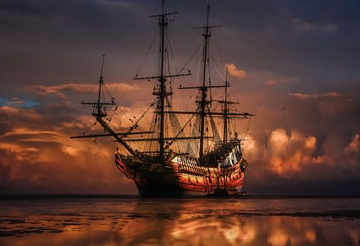
The Pirate Capital of the World: Port Royal, Jamaica
Share
In the late 17th century, Port Royal, Jamaica, was the wickedest city in the Western Hemisphere -- and the richest.
The city had been built on a spit of land guarding what is now known as Kingstown Harbor. It had been built primarily as a base to protect British interests in the New World. Easy access to the trade routes and a good, deep harbor made it an ideal base for pirates. Piracy -- or privateering, as it was called when done with government sanction -- was not only permitted, but encouraged, in old Port Royal. Raids on Spanish and French ships were in the interests of the British crown and were not illegal until 1687. The British government, with troops inadequate for the protection of Port Royal stationed there, also relied on the pirates for protection of the city.
As you can imagine, the wealth in the city was considerable. Goldsmith, silversmiths, prostitutes, artisans, and merchants of every description flocked to the city. At the height of its popularity, there was one tavern in Port Royal for every ten inhabitants. Some 200 buildings existed in the city, packed closely into an area of 51 acres. Most of the buildings were of brick, and some were four stories high. The city was so rich that the preferred medium of exchange was coin -- not barter, as was the case in the New World nearly everywhere else.
How many people lived in Port Royal in its "golden age"? At least 6500, it is estimated, and possibly as many as 10,000. It was the most populous city in the Western Hemisphere -- Boston, the second highest, had a population of only 6000.
On June 7, 1692, disaster struck Port Royal. The city had had small earthquakes before, but nothing like what happened on that day. Sometime between 11 a.m. and noon, three large earthquakes struck the city, immediately swallowing 2/3 of the city. A tsunami followed. All the ships in the harbor were destroyed -- one was found lodged on the top of a building where it became a refuge for survivors. It turned out that the city had not been built on bedrock, as had been supposed, but on loosely packed earth, which dissolved quickly and washed out to sea.
At least 3000 people died in the initial blast from nature. Most of the rest of the inhabitants died in the days that followed -- of disease, injuries, or in the wake of the general lawlessness that followed. Nearly every building in Port Royal was completely uninhabitable, including the two forts in the city. Looters arrived from the mainland. Port Royal was pretty much finished, it would appear.
Naturally, many individuals regarded this as a Judgment from God on the Wickedest City on Earth.
An attempt was made to rebuild Port Royal in the days that followed but were largely abandoned after a fire that destroyed the city again in 1703. Today Port Royal is a sleepy fishing village with a population of about 1800.
